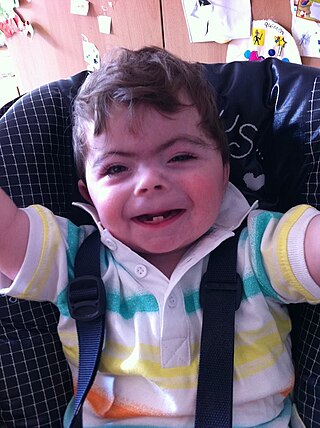Irene Ayako Uchida, was a Canadian scientist and Down syndrome researcher.

Arthrogryposis (AMC) describes congenital joint contracture in two or more areas of the body. It derives its name from Greek, literally meaning 'curving of joints'.

Noonan syndrome (NS) is a genetic disorder that may present with mildly unusual facial features, short height, congenital heart disease, bleeding problems, and skeletal malformations. Facial features include widely spaced eyes, light-colored eyes, low-set ears, a short neck, and a small lower jaw. Heart problems may include pulmonary valve stenosis. The breast bone may either protrude or be sunken, while the spine may be abnormally curved. Intelligence is often normal. Complications of NS can include leukemia.

Pediatric surgery is a subspecialty of surgery involving the surgery of fetuses, infants, children, adolescents, and young adults.
Widukind Lenz was a distinguished German pediatrician, medical geneticist and dysmorphologist who was among the first to recognize the thalidomide syndrome in 1961 and alert the world to the dangers of limb and other malformations due to the mother's exposure to this drug during pregnancy.

Cornelia de Lange syndrome (CdLS) is a genetic disorder. People with Cornelia de Lange syndrome experience a range of physical, cognitive, and medical challenges ranging from mild to severe. Cornelia de Lange syndrome has a widely varied phenotype, meaning people with the syndrome have varied features and challenges. The typical features of CdLS include thick or long eyebrows, a small nose, small stature, developmental delay, long or smooth philtrum, thin upper lip and downturned mouth.

Ogden Carr Bruton was a pediatrician and chief of pediatrics at Walter Reed Army Hospital, where he organized the first pediatric residency at this hospital. He made important advances in the field of immunology as an immunologist. The condition he discovered is sometimes referenced by his name: "Bruton-type agammaglobulinemia". The gene associated with this defect is also named after him: Btk, abbreviation for Bruton's tyrosine kinase.
David Weyhe Smith was an American pediatrician and dysmorphologist, best known for his pioneering book Recognizable Patterns of Human Malformation and for describing fetal alcohol syndrome.
Renata Laxova was a Czech American pediatric geneticist and a professor of genetics at the Departments of Pediatrics and Medical Genetics, Waisman Center, University of Wisconsin–Madison. She was the discoverer of the Neu-Laxová syndrome, a rare congenital abnormality involving multiple organs, with autosomal recessive inheritance.
Patricia Ann Baird, is a British medical geneticist active in Canada. Her research has specialized on the relationship between medical technology and ethics.
Julien I.E. Hoffman, FRCP was a pediatric cardiologist and professor emeritus of pediatrics and a senior member of the Cardiovascular Research Institute at the University of California, San Francisco. He has also worked at the Moffitt-Long Hospital at the UCSF Medical Center, and served on the medical advisory committee for the SIDS Alliance.
Lotte Strauss was a German-American pathologist.
Maria Iandolo New is a professor of Pediatrics, Genomics and Genetics at Icahn School of Medicine at Mount Sinai in New York City. She is an expert in congenital adrenal hyperplasia (CAH), a genetic condition affecting the adrenal gland that can affect sexual development.

Bruck syndrome is characterized as the combination of arthrogryposis multiplex congenita and osteogenesis imperfecta. Both diseases are uncommon, but concurrence is extremely rare which makes Bruck syndrome very difficult to research. Bruck syndrome is thought to be an atypical variant of osteogenesis imperfecta most resembling type III, if not its own disease. Multiple gene mutations associated with osteogenesis imperfecta are not seen in Bruck syndrome. Many affected individuals are within the same family, and pedigree data supports that the disease is acquired through autosomal recessive inheritance. Bruck syndrome has features of congenital contractures, bone fragility, recurring bone fractures, flexion joint and limb deformities, pterygia, short body height, and progressive kyphoscoliosis. Individuals encounter restricted mobility and pulmonary function. A reduction in bone mineral content and larger hydroxyapatite crystals are also detectable Joint contractures are primarily bilateral and symmetrical, and most prone to ankles. Bruck syndrome has no effect on intelligence, vision, or hearing.
Nadia Awni Sakati is a Syrian-Saudi pediatrician. Born on 23 May 1938 in Damascus, Syria, Sakati has contributed to the discoveries and advances in genetics medicine and has inspired numerous female professionals with her work.

John M. Opitz was a German-American medical geneticist and professor at the University of Utah School of Medicine. He is best known for rediscovering the concept of the developmental field in humans and for his detection and delineation of many genetic syndromes, several now known as the "Opitz syndromes" including Smith–Lemli–Opitz syndrome (SLOS), Opitz–Kaveggia syndrome (FGS1), Opitz G/BBB syndrome, Bohring–Opitz syndrome, and other autosomal and X-linked conditions. He is founder of the Wisconsin Clinical Genetics Center, the American Journal of Medical Genetics, and was a cofounder of the American College and American Board of Medical Genetics.
Wendy K. Chung is an American clinical and molecular geneticist and physician. She is the Chair of the Department of Pediatrics at Boston Children's Hospital and is on the faculty at Harvard Medical School. She is the author of 700 peer-reviewed articles and 75 chapters and has won several awards as a physician, researcher, and professor. Chung helped to initiate a new form of newborn screening for spinal muscular atrophy which is used nationally and was among the plaintiffs in the Supreme Court case which banned gene patenting.

Catherine Annie Neill was a British pediatric cardiologist who spent the majority of her career at the Johns Hopkins Children's Center in Baltimore, where she worked alongside Helen B. Taussig. Her primary interest was congenital heart defects; she discovered one type of defect, scimitar syndrome, in 1960.

Melissa A. Parisi is an American geneticist and physician. She is chief of the Intellectual and Developmental Disabilities Branch at the National Institute of Child Health & Human Development.
Allison Audrey Eddy is a Canadian nephrologist. She was the inaugural Hudson Family Hospital Chair in Pediatric Medicine at British Columbia Children's Hospital and a clinician-scientist at the British Columbia Children's Hospital.








